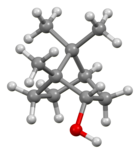Borneol
| |||
| |||
| Names | |||
|---|---|---|---|
| IUPAC name
rel-(1R,2S,4R)-1,7,7-Trimethylbicyclo[2.2.1]heptan-2-ol
| |||
| Other names
1,7,7-Trimethylbicyclo[2.2.1]heptan-2-endo-ol
endo-2-Bornanol, Borneo camphor | |||
| Identifiers | |||
| |||
3D model (JSmol)
|
|||
| ChEBI | |||
| ChEMBL | |||
| ChemSpider | |||
| ECHA InfoCard | 100.006.685 | ||
| EC Number |
| ||
| KEGG | |||
PubChemCID
|
|||
| UNII | |||
| UN number | 1312 | ||
CompTox Dashboard(EPA)
|
|||
| |||
| |||
| Properties | |||
| C10H18O | |||
| Molar mass | 154.253g·mol−1 | ||
| Appearance | colorless to white lumps | ||
| Odor | pungent,camphor-like | ||
| Density | 1.011 g/cm3(20 °C)[1] | ||
| Melting point | 208 °C (406 °F; 481 K) | ||
| Boiling point | 213 °C (415 °F; 486 K) | ||
| slightly soluble (D-form) | |||
| Solubility | soluble inchloroform,ethanol,acetone,ether,benzene,toluene,decalin,tetralin | ||
| −1.26×10−4cm3/mol | |||
| Hazards | |||
| GHSlabelling: | |||

| |||
| Warning | |||
| H228 | |||
| P210,P240,P241,P280,P370+P378 | |||
| NFPA 704(fire diamond) | |||
| Flash point | 65 °C (149 °F; 338 K) | ||
| Safety data sheet(SDS) | External MSDS | ||
| Related compounds | |||
Related compounds
|
Bornane(hydrocarbon) | ||
Except where otherwise noted, data are given for materials in theirstandard state(at 25 °C [77 °F], 100 kPa).
| |||
Borneolis abicyclicorganic compoundand aterpenederivative. Thehydroxylgroup in this compound is placed in anendoposition. The exo diastereomer is calledisoborneol.Being chiral, borneol exists asenantiomers,both of which are found in nature.
Reactions[edit]
Borneol isoxidizedto theketone(camphor).
Occurrence[edit]
The compound was named in 1842 by the French chemistCharles Frédéric Gerhardt.[2]Borneol can be found in several species ofHeterotheca,[3]Artemisia,Rosmarinus officinalis(rosemary)[4]Dipterocarpaceae,Blumea balsamiferaandKaempferia galanga.[5]
It is one of the chemical compounds found incastoreum.This compound is gathered from the beaver's plant food.[6]
Synthesis[edit]
Borneol can be synthesized byreductionofcamphorby theMeerwein–Ponndorf–Verley reduction(a reversible process). Reduction of camphor withsodium borohydride(fast and irreversible) gives instead thediastereomerisoborneol.
Uses[edit]
Whereasd-borneol was theenantiomerthat used to be the most readily available commercially, the more commercially available enantiomer now isl-borneol, which also occurs in nature.
Borneol fromDipterocarpusspp. is used intraditional Chinese medicine.An early description is found in theBencao Gangmu.
Borneol is a component of manyessential oils[7]and it is a naturalinsect repellent.[8]It also generates aTRPM8-mediated cooling sensation similar tomenthol.[9]
Laevo-borneol is used in perfumery. It has a balsamic odour type with pine, woody and camphoraceous facets.
Toxicology[edit]
Borneol may cause eye, skin, and respiratory irritation; it is harmful if swallowed.[10]Acute exposure may cause headache, nausea, vomiting, dizziness, lightheadedness, and syncope. Exposure to higher levels or over a longer period of time may cause restlessness, difficulty concentrating, irritability, and seizures.[11]
Skin irritation[edit]
Borneol has been shown to have little to no irritation effect when applied to the human skin at doses used in fine fragrance formulation.[12]Skin exposure can lead to sensitization and a futureallergic reactioneven to small quantities.[11]
Derivatives[edit]
The bornyl group is a univalent radical C10H17derived from borneol by removal of hydroxyl and is also known as 2-bornyl.[13]Isobornyl is the univalent radical C10H17that is derived from isoborneol.[14]Thestructural isomerfencholis also a widely used compound derived from certainessential oils.
Bornyl acetateis theacetateesterof borneol.
Notes and references[edit]
- ^Lide, D. R., ed. (2005).CRC Handbook of Chemistry and Physics(86th ed.). Boca Raton (FL): CRC Press. p. 3.56.ISBN0-8493-0486-5.
- ^C. Gerhardt (1842) "Sur la transformation de l'essence de valériane en camphre de Bornéo et en camphre des laurinées" (On the transformation of the essence of valerian into Borneo camphor and into laurel camphor),Comptes rendus,14:832-835.From p. 834:"Je donne, par cette raison, à l'hydrogène carboné de l'essence de valériane, le nom debornéène,et, au camphre lui-même, celui debornéol."(I give, for this reason [namely, that the compound that Gerhardt had obtained from valerian oil was identical to that obtained by Pelouze from camphor from Borneo], to the hydrocarbon from valerian essence, the namebornéène,and, to camphor itself, that ofborneol.)
- ^Lincoln, D.E., B.M. Lawrence. 1984. "The volatile constituents of camphorweed,Heterotheca subaxillaris". Phytochemistry 23(4): 933-934
- ^Begum, A.; Sandhya, S.; Shaffath Ali, S.; Vinod, K. R.; Reddy, S.; Banji, D. (2013). "An in-depth review on the medicinal flora Rosmarinus officinalis (Lamiaceae)".Acta Scientiarum Polonorum. Technologia Alimentaria.12(1): 61–73.PMID24584866.
- ^Wong, K. C.; Ong, K. S.; Lim, C. L. (2006). "Composition of the essential oil of rhizomes ofKaempferia GalangaL. ".Flavour and Fragrance Journal.7(5): 263–266.doi:10.1002/ffj.2730070506.
- ^The Beaver: Its Life and Impact. Dietland Muller-Schwarze, 2003, page 43 (book at google books)
- ^Plants containing borneolArchived2015-09-23 at theWayback Machine(Dr. Duke's Phytochemical and Ethnobotanical Databases)]
- ^"Chemical Information".sun.ars-grin.gov. Archived fromthe originalon 2004-11-07.Retrieved2008-03-02.
- ^Chen, GL; Lei, M; Zhou, LP; Zeng, B; Zou, F (2016)."Borneol Is a TRPM8 Agonist that Increases Ocular Surface Wetness".PLOS ONE.11(7): e0158868.Bibcode:2016PLoSO..1158868C.doi:10.1371/journal.pone.0158868.PMC4957794.PMID27448228.
- ^Material Safety Data Sheet.Fisher Scientific.
- ^abHAZARDOUS SUBSTANCE FACT SHEET(PDF)
- ^Bhatia, S.P.; Letizia, C.S.; Api, A.M. (November 2008)."Fragrance material review on borneol".Food and Chemical Toxicology.46(11): S77–S80.doi:10.1016/j.fct.2008.06.031.PMID18640181.
- ^"Definition of BORNYL".merriam-webster.
- ^"Definition of ISOBORNYL".merriam-webster.






